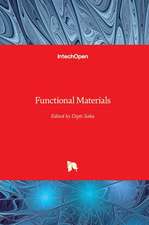Silicon Versus Carbon: Fundamental Nanoprocesses, Nanobiotechnology and Risks Assessment: NATO Science for Peace and Security Series B: Physics and Biophysics
Editat de Yuri Magarshak, Sergey Kozyrev, Ashok K. Vaseashtaen Limba Engleză Paperback – 30 iun 2009
| Toate formatele și edițiile | Preț | Express |
|---|---|---|
| Paperback (1) | 1822.26 lei 6-8 săpt. | |
| SPRINGER NETHERLANDS – 30 iun 2009 | 1822.26 lei 6-8 săpt. | |
| Hardback (1) | 1828.29 lei 6-8 săpt. | |
| SPRINGER NETHERLANDS – 8 iun 2009 | 1828.29 lei 6-8 săpt. |
Din seria NATO Science for Peace and Security Series B: Physics and Biophysics
- 18%
 Preț: 955.25 lei
Preț: 955.25 lei - 18%
 Preț: 1222.62 lei
Preț: 1222.62 lei - 24%
 Preț: 1057.17 lei
Preț: 1057.17 lei - 24%
 Preț: 788.31 lei
Preț: 788.31 lei - 18%
 Preț: 1223.74 lei
Preț: 1223.74 lei - 18%
 Preț: 1830.34 lei
Preț: 1830.34 lei - 15%
 Preț: 643.99 lei
Preț: 643.99 lei - 18%
 Preț: 1212.36 lei
Preț: 1212.36 lei - 18%
 Preț: 947.85 lei
Preț: 947.85 lei - 18%
 Preț: 950.52 lei
Preț: 950.52 lei - 20%
 Preț: 565.64 lei
Preț: 565.64 lei - 18%
 Preț: 950.66 lei
Preț: 950.66 lei - 24%
 Preț: 1060.06 lei
Preț: 1060.06 lei - 5%
 Preț: 1412.06 lei
Preț: 1412.06 lei - 18%
 Preț: 1226.90 lei
Preț: 1226.90 lei - 18%
 Preț: 945.79 lei
Preț: 945.79 lei - 18%
 Preț: 1221.20 lei
Preț: 1221.20 lei - 24%
 Preț: 789.61 lei
Preț: 789.61 lei - 18%
 Preț: 947.67 lei
Preț: 947.67 lei - 24%
 Preț: 1053.41 lei
Preț: 1053.41 lei - 18%
 Preț: 1834.77 lei
Preț: 1834.77 lei - 18%
 Preț: 943.08 lei
Preț: 943.08 lei - 15%
 Preț: 640.06 lei
Preț: 640.06 lei - 18%
 Preț: 945.30 lei
Preț: 945.30 lei - 18%
 Preț: 1217.62 lei
Preț: 1217.62 lei - 18%
 Preț: 951.14 lei
Preț: 951.14 lei - 18%
 Preț: 1216.02 lei
Preț: 1216.02 lei - 18%
 Preț: 1839.17 lei
Preț: 1839.17 lei - 15%
 Preț: 645.47 lei
Preț: 645.47 lei - 18%
 Preț: 1220.57 lei
Preț: 1220.57 lei - 18%
 Preț: 1217.90 lei
Preț: 1217.90 lei - 18%
 Preț: 1228.96 lei
Preț: 1228.96 lei - 18%
 Preț: 1232.71 lei
Preț: 1232.71 lei - 15%
 Preț: 652.17 lei
Preț: 652.17 lei - 18%
 Preț: 1220.88 lei
Preț: 1220.88 lei - 15%
 Preț: 639.73 lei
Preț: 639.73 lei - 18%
 Preț: 1224.36 lei
Preț: 1224.36 lei - 18%
 Preț: 1828.29 lei
Preț: 1828.29 lei
Preț: 1822.26 lei
Preț vechi: 2222.27 lei
-18% Nou
Puncte Express: 2733
Preț estimativ în valută:
348.80€ • 379.00$ • 293.18£
348.80€ • 379.00$ • 293.18£
Carte tipărită la comandă
Livrare economică 21 aprilie-05 mai
Preluare comenzi: 021 569.72.76
Specificații
ISBN-13: 9789048125227
ISBN-10: 9048125227
Pagini: 432
Ilustrații: XIV, 416 p.
Dimensiuni: 155 x 235 x 30 mm
Greutate: 0.6 kg
Ediția:2009
Editura: SPRINGER NETHERLANDS
Colecția Springer
Seria NATO Science for Peace and Security Series B: Physics and Biophysics
Locul publicării:Dordrecht, Netherlands
ISBN-10: 9048125227
Pagini: 432
Ilustrații: XIV, 416 p.
Dimensiuni: 155 x 235 x 30 mm
Greutate: 0.6 kg
Ediția:2009
Editura: SPRINGER NETHERLANDS
Colecția Springer
Seria NATO Science for Peace and Security Series B: Physics and Biophysics
Locul publicării:Dordrecht, Netherlands
Public țintă
ResearchCuprins
Is “Silicate Life” Possible?.- Nanocarbon Technologies: Prospects and Risks.- Advanced Environment Friendly Nanotechnologies.- Novel Environment Friendly Method of Preparing Nanoreinforced Composites Based on Metallic, Ceramic and Polymer Matrixes – Superdeep Penetration.- Sdp Technology for “Green” Technology of Metallic Reinforced Nanocomposites.- Substantiation of International Nanomaterials Security Group Creation.- Matter Structuring in Nano Scales and Fundamental Constants of Physics.- Size Evolution of Nanoclusters: Comparison Between the Phase Diagram and Properties of MO–S and Carbon Nanoparticles.- Nanomaterials Nexus in Environmental, Human Health, and Sustainability.- Nanotechnology and Quasicrystals: From Self-Assembly to Photonic Applications.- Oscillations of Polarized Charge in Solution of Salt in Polar Dielectric: Possible Application in Element and Isotope Separation in Biology and Nanotechnology.- On the Possible Influence of Resonance Conversion on Formation of the Organic Structures.- Field Driven Current in Nonlinear Low-Dimensional Nanosystems.- The Impact of Novel Technologies on the Environment Throughout History.- Nanotechnoscience as a Cluster of the Different Natural and Engineering Theories and Nanoethics.- Risk in Decision-Oriented and Self-Changing Society.- Technology-Induced Risks in History.- Nanotechnology: Perspective for Future and Nanorisks.- Evaluation of Sustainability of the Carbon and Silicon Ecosystem: From Nanoparticles to Macroworld.- Carbon Discs and Carbon Cones — New High Risk Materials for Nano-Sensors With Low Detection Limit and Fast Kinetics.- Biodynsensing: Sensing Through Dynamics of Hybrid Affinity/Cellular Platforms; Towards Appraisal of Environmental and Biological Risks of Nanobiotechnology.-Synthesis and Utilization of Hyperbranched Poly(Amino Acids) as Carriers of Biologically Active Substances: Problems and Solutions.- Biodegradable and Biocompatible Carbon-Chain Polymer–Protein Conjugates as Carriers of Biologically Active Substances: Problems of Synthesis, Risks of Application and How to Overcome Them.- Modern Risks of Anthropogenic Influence on Living Species: Nano-Level Fluctuation.- Application of Fulleroid Nano-Carbon In Sorption Techniques.- Aspects of Microparticle Utilization for Potentiation of Novel Vaccines: Promises and Risks.
Caracteristici
Will be of considerable value as a secondary text for universities currently offering courses in nanotechnology Constitutes a valuable source of information on nanostructured materials for those interested in the related aspects of the field, such as nano-biotechnology, environmental friendly nanotechnologies, environmental and biological risks of nanobiotechnology, nanobionics and hybrid organic-silicon nanodevices





















